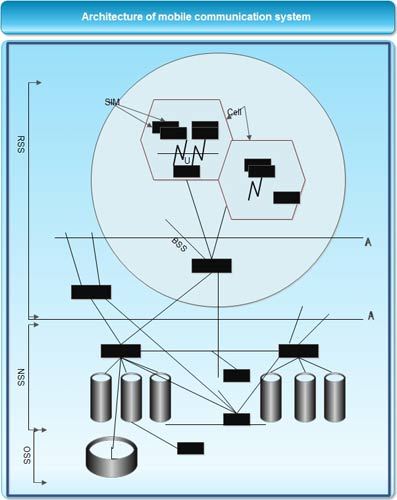The generic GSM network architecture is composed of three subsystems as the Radio Subsystem (RSS), the network and Switching Subsystem (NSS) and the Operation Subsystem (OSS). The subscriber carries the Mobile Station, which is part or RSS.

The RSS basically consists of radio specific equipment such as mobile station (MS), Base Station Subsystem (BSS) to control the radio link. The connection between RSS and NSS is established with A interface based on circuit switched PCM·30 system with 2.048 Mbit/s date rate. The chief components of ass are BSS, cellular layout and base station controller (BSC).
We’ll be covering the following topics in this tutorial:
Radio Substation (RSS)
The RSS consists of the components that are necessary in order to allocate the radio resources to the individual subscribers. It principally consists of the mobile terminals (mobile phone or mobile station, MS) and the base station subsystem (BSS).
Base Station Subsystem (BSS)
The Mobile Station and the Base Station Subsystem communicate across the Um interface, also known as the air interface or radio link. A BSS is controlled by a BSC.A BSS maintains radio connections to an MS, coding/decoding of voice and data rate adaptation to/from the wireless network part. There may be many BSS in a GSM network and each BSS contains several MS. Base transceiver station (BTS) and a base station controller (BSC) along with the cellular layout. These communicate across a standardized Abis interface, allowing operation between components made by different suppliers.
Mobile Station (MS)
MS is basically mobile equipment (the handset) which comprises all user equipment and software needed for mobile communication and a smart card called the Subscriber Identity Module (SIM). The MS, which contain a SIM, card in the form of a very small chip b\side the equipment.
The Subscriber Identity Module (SIM) contains all subscriber information necessary for identifying GSM subscriber. Broadly, it holds a subscriber’s International Mobile Subscriber Identity (IMSI), authentication key and algorithm. SIM is independent of the device or handset In which it is being used because an MS can be identified via International Mobile Equipment Identity (IMEI). As soon as the SIM is inserted into handset, it becomes immediately programmed for use. Therefore, it can be inserted into any handset. If you have forgotten to carry your handset but are carrying your SIM card, it can be inserted in any borrowed phone for use. Without SIM a handset can access only emergency services. Advances in memory and processing capacity has enabled SIM cards to be programmed to display custom menus for personalized services and therefore, makes it different from conventional cellular phones, Typically, mobile stations have transmitted power from 2 W to 1W depending upon the cell size, If cell size is smaller, the transmitted power will be less.
 Dinesh Thakur holds an B.C.A, MCDBA, MCSD certifications. Dinesh authors the hugely popular
Dinesh Thakur holds an B.C.A, MCDBA, MCSD certifications. Dinesh authors the hugely popular